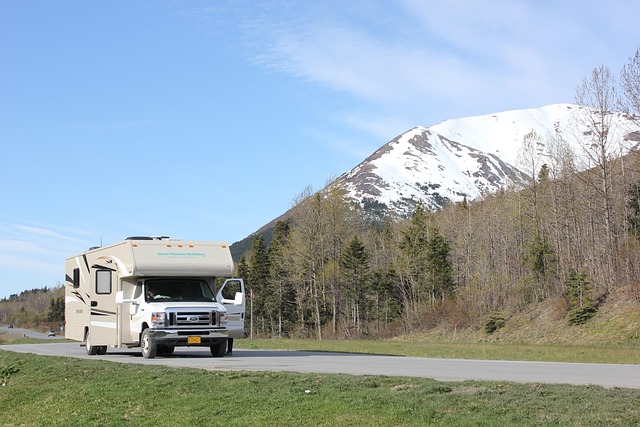Embarking on your first RV trip as a beginner should be an exciting journey with proper preparation. The 'RVing for Beginners' guide emphasizes understanding your RV's systems, including plumbing, electrical, propane, and water tanks. It's essential to explore various campground options, choose the right amenities, and master setting up camp level to enhance both comfort and vehicle longevity. Newcomers should also learn to connect their RV to utilities, manage interior temperature, utilize energy sources effectively, and become familiar with unique appliances like the refrigerator and microwave. Selecting the appropriate RV type for your lifestyle is crucial, with options ranging from travel trailers for flexibility to Class A motorhomes for luxury, Class B camper vans for ease of navigation, and Class C motorhomes that offer a balance between comfort and maneuverability. Before hitting the road, thorough vehicle inspection, emergency kit preparation, and packing are necessary to ensure safety and comfort. Preparing an emergency kit, stocking essential supplies, understanding your RV's layout, and careful route planning will lay the groundwork for a successful trip. For those new to RVing for Beginners, it's important to be aware of common issues and know how to address them promptly, such as checking seals for water leaks, leveling your RV to prevent malfunctions, resetting breakers or tightening electrical connections, and ensuring your refrigerator is properly leveled. By anticipating and prepared to handle these issues, beginners can enjoy a smooth and memorable RV adventure with confidence.
Embark on a journey of adventure and comfort with “RVing for Beginners: Your Comprehensive Guide to First-Time Camping.” This article is your roadmap to seamlessly setting up camp and enjoying the great outdoors from the comfort of an RV. Whether you’re selecting your first recreational vehicle or preparing for your maiden voyage, we cover the essentials, from understanding the basics of RVing to troubleshooting common issues. Follow our easy-to-follow instructions in “Setting Up Camp: Step-by-Step Instructions for RV Newbies” and transform your travel into a stress-free and enjoyable experience. Join us as we guide you through every aspect of RV camping, ensuring your journey is filled with new discoveries and memorable moments.
- Understanding the Basics of RVing for Beginners: What to Expect
- Choosing Your First RV: A Newcomer's Guide to RV Types and Features
- Pre-Departure Preparation: Essential Steps Before Hitting the Road
- Setting Up Camp: Step-by-Step Instructions for RV Newbies
- Troubleshooting Common Issues: Quick Fixes for Beginner RVers
Understanding the Basics of RVing for Beginners: What to Expect

Embarking on your first RV adventure is an exciting journey into the great outdoors, offering a blend of comfort and adventure. As you navigate the basics of RVing for beginners, it’s crucial to familiarize yourself with the various systems within your recreational vehicle. From understanding the intricacies of the plumbing and electrical setups to learning how to manage your RV’s propane and water tanks, each aspect plays a vital role in ensuring a smooth camping experience. Beginners should also acquaint themselves with the different types of campgrounds available, ranging from full-service hookup sites to more rustic, back-to-basics locations. Knowing what amenities are provided will help you plan and pack accordingly, ensuring your RVing trip is both enjoyable and practical.
When setting up camp for the first time, take note of the layout of your chosen site. Leveling your RV is a fundamental step to prevent interior damage and to ensure comfortable living conditions; use leveling blocks or a leveling system to achieve this. Next, connect your RV to water and sewage systems if available, and understand how to operate your RV’s air conditioning and heating systems to maintain a comfortable temperature regardless of the weather outside. Familiarize yourself with the RV’s battery and solar panel setup to keep electronics charged, and learn how to properly use the RV’s appliances, such as the refrigerator and microwave, which often operate differently from their household counterparts. By understanding these basics of RVing for beginners, you’ll be well-prepared for a memorable and rewarding camping experience.
Choosing Your First RV: A Newcomer's Guide to RV Types and Features

Embarking on your first RV adventure can be an exhilarating experience, and choosing the right RV is a crucial step in ensuring your journey is comfortable and enjoyable. For those new to RVing for Beginners, it’s essential to familiarize yourself with the various types of RVs available and their distinct features. There are primarily four categories to consider: travel trailers, which are towable by a variety of vehicles; Class A motorhomes, the largest and often most luxurious RVs on the road; Class B camper vans, ideal for those seeking a compact yet functional living space; and Class C motorhomes, a middle-ground option that combines elements of both classes A and B. Each type offers unique benefits and is suited to different lifestyles and preferences. For instance, travel trailers allow for more vehicle versatility as you can use your tow vehicle for everyday purposes when not on the road. Class A motorhomes, on the other hand, provide the comforts of home with their expansive living spaces and amenities. Class B camper vans are perfect for solo travelers or couples who value maneuverability and ease of parking in tight spots. Class C motorhomes blend the features of a Class A with the maneuverability of a Class B, making them a popular choice among RVing for Beginners enthusiasts. When selecting your first RV, consider factors such as the size of your family, your intended destinations, and the kind of activities you plan to engage in while on your travels. Additionally, take into account the ease of setup and breakdown, storage space, vehicle compatibility, and the overall layout that best fits your lifestyle. By carefully considering these aspects, you’ll be well-equipped to choose an RV that suits your needs and enhances your outdoor experiences.
Pre-Departure Preparation: Essential Steps Before Hitting the Road

As you embark on your inaugural RV adventure, pre-departure preparation is pivotal to ensure a smooth and enjoyable journey. For rookie RVers, it’s crucial to plan ahead and familiarize yourself with the essentials of RV living. Begin by carefully inspecting your RV, both inside and out. Check all systems, including water, electricity, gas, and plumbing, ensuring they are in good working order. Verify that the tires, brakes, lights, and battery are functioning as expected. Don’t forget to pack an emergency kit complete with tools, first aid supplies, and necessary medications. Load your RV with the necessities: food, cooking equipment, bedding, clothing suitable for the climate, and toiletries. Familiarize yourself with the RV layout, including where the water, sewer, and electricity hookups are, as well as the location of safety features like fire extinguishers and smoke detectors. Planning your route in advance can help avoid unnecessary stress, especially if you’re new to RVing for Beginners. Use reliable apps or maps to identify campgrounds, rest areas, and points of interest along the way. By taking these preliminary steps, you’ll set a solid foundation for a memorable and hassle-free RVing experience. Remember to also organize your personal documents, such as driver’s license, insurance information, and RV registration, keeping them easily accessible during your trip. With careful planning and attention to detail, your first RV camping setup will be a journey to remember for all the right reasons.
Setting Up Camp: Step-by-Step Instructions for RV Newbies

Embarking on your first RV adventure can be both exhilarating and daunting, but with the right guidance, setting up camp becomes a seamless process. For those who are RVing for Beginners, understanding the fundamentals of RV setup is crucial for an enjoyable journey. Upon arrival at your chosen campsite, begin by scouting the area for the best spot that meets your needs—consider levelness, shade, and proximity to facilities. Use the RV’s leveling system or leveling blocks to ensure stability; an unleveled RV can cause discomfort and potential damage. Next, connect your RV to the water, electricity, and sewer hookups, if available. Always follow the correct connections for freshwater, grey water, and black water to prevent mix-ups and contamination. Once your RV is securely connected and level, extend your slides (if equipped) to provide additional space and comfort inside.
Inside your RV, familiarize yourself with the layout and locate essential items such as the water pump, battery switch, and propane tank controls. Ensure that all appliances are off before connecting to electricity to prevent electrical surges or fires. After setting up your power supply, you can turn on the water pump to ensure a steady water supply throughout the RV. Proceed to test your air conditioning, heating, and other amenities to guarantee they’re functioning correctly. Finally, secure your awning for an outdoor living space, and you’re all set to enjoy your camping experience. Remember to keep safety as a priority throughout the setup process; follow the manufacturer’s guidelines specific to your RV model. With these step-by-step instructions, RVing for Beginners will find setting up camp a rewarding experience that paves the way for unforgettable travels and adventures.
Troubleshooting Common Issues: Quick Fixes for Beginner RVers

When embarking on your first RV camping trip, you may encounter a myriad of issues, from minor annoyances to more pressing problems. Being prepared with quick fixes for common concerns can enhance your experience and ensure that your journey is as smooth as possible. For instance, if you find water pooling in your RV’s slide-outs, check the rubber seals or gaskets; they may have shrunk over time or improperly installed. A simple resealing or adjustment can typically resolve this issue. Similarly, if your refrigerator isn’t maintaining the correct temperature, verify that it’s leveled to prevent coolant from flowing to one side. Adjusting the legs can be a swift remedy for this common problem. RV newcomers should also familiarize themselves with their RV’s electrical system. If you experience electrical issues like flickering lights or dead outlets, first reset the breakers and check for any loose connections. Inspecting your RV’s battery terminals to ensure they are clean and tight can often rectify power supply problems. Additionally, learning how to properly use your RV’s water system is crucial to avoid leaks and damage. If you detect a water leak, locate your RV’s water lines and check for any bursts or disconnections. A quick tighten or repair can prevent extensive water damage. Lastly, when it comes to leveling your RV, an uneven setup can lead to a host of issues from door malfunctions to refrigerator inefficiencies. Utilize your RV’s leveling system, and if necessary, add leveling blocks under the low side. By addressing these common issues with these simple fixes, RVers can ensure their first camping experience is a positive one, laying the foundation for many more adventures on the road.
Embarking on an RV journey for the first time can be an exhilarating experience, filled with adventure and discovery. With the guidance provided in this article on RVing for Beginners, from choosing the right RV to mastering the setup process, you are now equipped with the knowledge to confidently hit the road and make unforgettable memories. Whether it’s understanding the basics, preparing your RV before departure, or troubleshooting common issues, each step has been outlined with ease. Remember, the journey of RVing is as much about the destinations as it is about the experiences along the way. Safe travels and happy camping!
